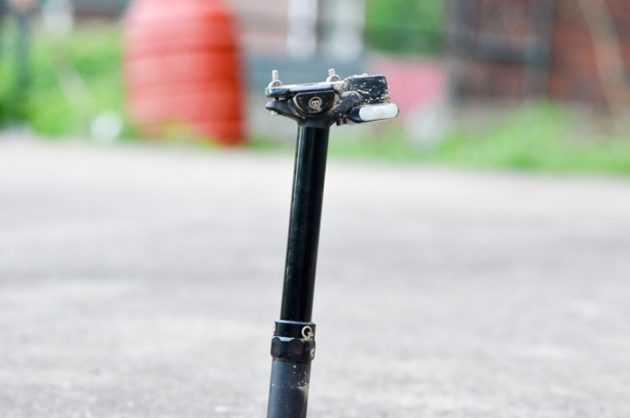Review: Magura Vyron wireless dropper post
Originally posted on October 26, 2016 at 8:00 amTester: Eric McKeegan
Price: $500
Wireless actuation of devices is well-established in the tech world, but Magura is one of few using it in the bike world. While some might expect my normally curmudgeonly self to be grumpy about the complexity of an electronic system replacing mechanical devices, I’m willing to make an exception for droppers. Unlike cables on drivetrains, the cable routing for droppers is often terrible, particularly with internally routed posts. The posts also seem very sensitive to small changes in cable tension or contamination, and the tiny bolts used to secure the cable are often not up to the task. Even sliding the post up to clamp it in a work stand is a pain. Eliminating the cable makes all this just go away.
But much like the first generation of new tech devices, the first wireless dropper to hit the market needs refinement. Inside the post a small servomotor spins the valve open and closed, and is good for about 400 activations, which is easily 10 rides for most people. The battery is charged with a micro-USB cord, which is ubiquitous these days. The post comes with 150 mm of drop in the most common 31.8 or 30.9 diameters. The post and remote together weigh 570 grams in the 30.9 size, slightly lighter than Magura’s claimed weight.
The three-button remote is an existing part from Magura’s wireless suspension lockout. A single push of the middle button actuates the servo. Because the valve is “spun” open by the servo, there is a delay as the valve opens. During that short (less than a second) delay, the saddle needs to be weighted, or the valve will close itself. This might sound complicated, but it only took part of a ride to figure out the timing.
Since you aren’t holding the valve open with the remote (which is how most droppers work), the post senses when oil flow stops and closes the valve. That means I needed to keep the saddle at the desired height for another fraction of a second. This took longer to get the timing down, and on rough terrain it could be difficult to hold the seat steady long enough to stop the oil flow. This mostly applied to setting the seat between fully up and down; just slamming it to the bottom stop and holding it was a reliable way to ensure the valve closed.

The remote mounts with a simple o-ring; I never found a very ergonomic placement with Shimano or SRAM brake lever clamps, and I didn’t get a chance to try it with Magura’s brakes. While wearing gloves it was almost impossible to feel which button was which, often leading to frustrated mashing with the thumb to get the seat down.
And finally, after a multi-hour ride in rain, mostly on pavement, the post became sticky on the return stroke. After checking air pressure and ensuring the seat binder wasn’t too tight, I dripped some lube around the seal, which fixed the issue, but had to be repeated every few rides until the problem went away. The owner’s manual (should have consulted it first) revealed this as a no-no, and sticky posts should be sent back to Magura for service.
I talked to Magura about this issue, the response: “Although having ridden our Vyrons in all sorts of conditions we didn’t see this sticking. Could you send us your post for inspection through Magura USA? We can then check if an additional lubrication like you did is a possible solution, that could be communicated also through us.” The post is headed back to Magura; we’ll update the web version of this review when we hear back.
On paper there is so much to love about this post, and the construction materials and finishes are top-notch, but as a competitor to the best droppers on the market, the Vyron comes up short. Magura has an updated remote in the works with bigger buttons, which should eliminate one frustration with the performance of this post.
For anyone but the most tech-geek of early adopters there is little reason to recommend this post over other droppers on the market. But I hope people buy it anyway. This might motivate Magura to develop a shorter travel version that would be excellent for all-road/gravel bikes, which is where I see this technology being most applicable.
